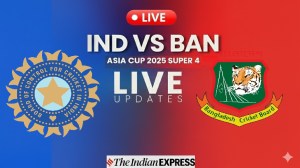Battle of the ballot
During World War II, I had a wonderful colleague, Captain Tom Walsh. He had several claims to fame. One, he was the son-in-law of our comman...

During World War II, I had a wonderful colleague, Captain Tom Walsh. He had several claims to fame. One, he was the son-in-law of our commandant, Col V.C. Alderson. Col Alderson had no daughter. Two, he was taken a prisoner of war at Bengazi in Libya. He had never been to Bengazi. Three, he had shot down three spitfires over London. When Luftwaffe was bombing England, Walsh was signing sheet rolls of soldiers in Ferozepur cantonment in India. Of course, he had tried to become an artillery officer. But artillery did not accept him. Nor did infantry. For, medically, Walsh was category C, fit for garrison duty only.
Walsh never liked his posting to Ferozepur. But since “theirs not to reason why; theirs but to do and die,” Walsh carried on his Charge of the Light Brigade from Ferozepur itself. He was given the responsibility of administering four sections at the headquarters of the Royal Indian Army Service Corps. Every section had a specific duty to perform. Section A handled cases of soldiers AWL (absent without leave). Section B took care of provisions including housewife, a small bag containing needles, thread and buttons, intended to enable soldiers to take care of minor repairs to their uniforms. Section C made appropriate entries in the sheet rolls and Section D saw to it that these entries were strictly according to army regulations. No noting could be done on sheet rolls. Any flaw found anywhere had to be brought to the notice of the section concerned through a letter.
All sections worked under blokes called burrah babus, pastmasters in the art of making mountains out of molehills. They were not authorised to sign letters. Capt Walsh had to sign them. There were cases in which Section D would call for the explanation of Section A or B for doing something wrong. Section A or B would apologise to Section D. Since all letters were signed by Capt Walsh, that meant that through one letter Walsh was calling for his own explanation and through another he was apologising to himself.
One day, Col Alderson called Walsh to his room and gave him a terrific dressing down. “How can you,” he asked Walsh, “call for your own explanation in one letter and apologise to yourself in another?” What explanation could poor Walsh give to that?
I am reminded of that glorious episode from my war days as I watch the great battle of the ballot going on in India today. Several burrah babus are furiously at work, arranging unholy alliances, turning illegitimacy into legitimacy. They have roped in glamorous filmstars, old and new. But the Indian voter is no Capt Walsh. On the crucial polling day, he will press the button he knows he should.
Photos



- 01
- 02
- 03
- 04
- 05




























